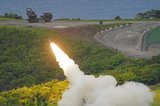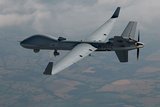Northrop Grumman Completes Initial MP-RTIP Radar Performance Verification Flights
Northrop Grumman Corporation has completed initial testing of the Multi-Platform Radar Technology Insertion Program (MP-RTIP) sensor.
All dedicated mode flights have been completed in the Radar System Level Performance Verification (RSLPV) program, verifying system performance of the Synthetic Aperture Radar (SAR) and Ground Moving Target Indicator (GMTI) modes.
This new sensor is slated for the RQ-4 Block 40 Global Hawk high-altitude long-endurance (HALE) unmanned aircraft system (UAS). Assembly of the first Block 40 aircraft, AF-18, is complete and awaiting the Air Force to begin flight testing.
"This is a major milestone for the MP-RTIP program," said Duke Dufresne, vice president and general manager of the company's Strike and Surveillance Systems Division. "We are ready to deliver the first Global Hawk airframe for flight test and quickly follow-up with sensor integration for operational test and evaluation. Delivering this capability to our men and women in uniform will be a game changer in the ability to detect and track adversaries on the battlefield.
"Additionally, the MP-RTIP sensor is a major element in the Alliance Ground Surveillance program for NATO, which includes eight Block 40 Global Hawks," he said.
The RSLPV flight test program is being conducted by the U.S. Air Force Operational Test and Evaluation Center. The radar is being flown on Northrop Grumman's Proteus aircraft as a surrogate for the first Block 40 Global Hawk. By verifying sensor performance on Proteus, the sensor testing progressed without impact to production, significantly lowering the risk with regard to the Block 40 Global Hawk's operational capability.
Concurrent mode testing for RSLPV is scheduled to be completed this summer, verifying full sensor capability prior to installation and testing on Global Hawk.
Northrop Grumman is the prime contractor for the MP-RTIP and Global Hawk programs and continues to move these technologies forward under the stewardship of the Air Force's Aeronautical Systems Center at Wright-Patterson Air Force Base, Ohio, and the Electronic Systems Center, located at Hanscom Air Force Base, Mass. Northrop Grumman's Norwalk, Conn., facility is the principal MP-RTIP radar developer along with principal subcontractor, Raytheon Space and Airborne Systems, El Segundo.
The Global Hawk system has logged almost 31,000 total program flight hours, of which nearly 24,000 hours were flown in support of current overseas contingency operations. The Global Hawk's range, endurance and large payload capabilities make it an ideal system to support a variety of customers.
The Global Hawk is the world's first fully autonomous HALE UAS, collecting persistent ground surveillance data over a wide area for both military intelligence analysis and warfighters' battle management and targeting. Global Hawk will fly up to 60,000 feet for more than 32 hours providing surveillance day or night, regardless of weather conditions.
More from Uncrewed Vehicles
-
![What's next for the Pentagon after the Replicator programme?]()
What's next for the Pentagon after the Replicator programme?
Although the Replicator initiative has made several accomplishments, there are still multiple gaps to plug across the US Department of Defense (DoD) and its services.
-
![Cummings Aerospace showcases Hellhound loitering munition designed for US Army’s LASSO programme (video)]()
Cummings Aerospace showcases Hellhound loitering munition designed for US Army’s LASSO programme (video)
Cummings Aerospace presented its turbojet-powered Hellhound loitering munition at SOF Week 2025, offering a man-portable solution aligned with the US Army’s LASSO requirements.
-
![SOF Week 2025: PDW unveils attritable FPV drone for SOF operations at scale]()
SOF Week 2025: PDW unveils attritable FPV drone for SOF operations at scale
PDW has revealed its Attritable Multirotor First Person View drone at SOF Week 2025, offering special operations forces a low-cost, rapidly deployable platform for strike and ISR missions, inspired by battlefield lessons from Ukraine.
-
![SOF Week 2025: Teledyne FLIR white paper provides guidance on reusable loitering munitions]()
SOF Week 2025: Teledyne FLIR white paper provides guidance on reusable loitering munitions
Teledyne FLIR is highlighting the emerging requirements for 'recoverable and re-usable' loitering munitions across the contemporary operating environment during this week’s SOF Week conference in Tampa, Florida.
-
![SOF Week 2025: Kraken Technology group debuts K3 Scout USV in North America]()
SOF Week 2025: Kraken Technology group debuts K3 Scout USV in North America
High-performance maritime industry player Kraken Technology Group, based in the UK, has used the SOF Week conference in Tampa, Florida this week to debut its K3 Scout uncrewed surface vessel (USV) to the North American market.
-
![Palladyne AI and Red Cat to demonstrate capabilities for autonomous drone swarms to the US military]()
Palladyne AI and Red Cat to demonstrate capabilities for autonomous drone swarms to the US military
Red Cat and Palladyne AI recently conducted a cross-platform collaborative flight involving three diverse heterogeneous drones.

























